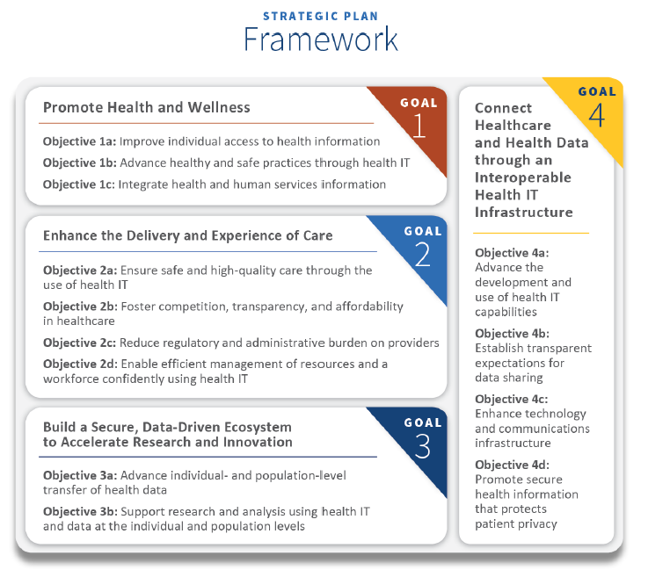How the Federal Health IT Plan Impacts Data Interoperability
The federal health IT strategic plan has ambitious goals for data interoperability that will put providers on a new path for leveraging the data that has been digitized over the past decade.

Source: Getty Images
- In its release of the Federal Health IT Strategic Plan in January, the Office of the National Coordinator set priorities for focus and spending. While one purpose of this plan is to ensure that government agencies are aligned in their approach to healthcare, the plan has implications for all in the healthcare industry especially in terms of data interoperability.
The strategic plan outlined four goals:
- Promote health and wellness
- Enhance the delivery and experience of care
- Build a secure, data-driven ecosystem to accelerate research and innovation
- Connect healthcare and health data through an interoperable health IT infrastructure
Goal 4, in particular, revolves around data interoperability and data management. The availability of data will act as a foundational element for the success of the other three goals. As seen in the diagram below, the strategic plan presents Goal 4 not as another item in the list, but as structural element that will support the entire strategic plan.

Source: The Office of the National Coordinator for Health IT
Leveraging the Digital Foundation of Meaningful Use
Goal 4 of the strategic plan builds on what has already been accomplished with EHR adoption through Meaningful Use. In a letter from the National Coordinator, Donald W. Rucker, MD, stated that “most healthcare providers and health systems now use electronic health records (EHRs), but information captured in these systems often remains inaccessible to patients, caregivers, and healthcare providers across different settings.”
Said in a different way, Meaningful Use was successful in digitizing the industry but largely failed to deliver on its name — providing patients and caregivers access to information they can use in a meaningful way. So, in a sense, the strategic plan paves a path for completing and achieving what Meaningful Use started.
This path forward relies on a pair of rules authored by the ONC and CMS. Released in 2019, the CMS proposed rule focuses on information exchange, patient access, care coordination, and the use of standards-based APIs. The accompanying ONC proposed rule provides guidance around the standards-based APIs — specifically HL7 FHIR, certification requirements, and information blocking provisions.
The strategy of building on what has been accomplished with EHR adoption by Meaningful Use and expanding beyond that to true interoperability is meant to lead the industry toward truly interoperable data among patients, providers, and payers.
Achieving Interoperability Through HL7 FHIR
While the strategic plan itself only mentions HL7 FHIR twice, it is the key standard embedded within the ONC and CMS proposed rules. FHIR will be critical in delivering on the fourth goal of an interoperable health IT infrastructure.
Healthcare has historically lagged behind other industries in adopting modern IT technologies. HL7 FHIR was designed from the ground up to support modern technologies and apply them to healthcare. HL7 FHIR is based on secure web services with JSON and XML encoding options — the same technologies used in social media and app development.
Using modern technologies has the advantages of providing secure data transfer through modern encryption, authorization, and access that are known and well understood across industries. This not only makes secure data delivery possible at the point of care, but also frees-up data for secure analytic capabilities and machine learning as outlined in Goal 3 of the strategic plan.
The focus of FHIR was made clear at the ONC Annual Meeting, which took place two weeks after the release of the strategic plan. At times, the conference could have been mistaken for an HL7 FHIR conference, with many sessions focused on how HL7 FHIR will be leveraged to deliver on an interoperable infrastructure.
Transparent Expectations for Data Sharing
While technology components allow the industry to deliver on an interoperable infrastructure, in Objective 4b under Goal 4, the strategic plan addresses transparent expectations for data sharing — more commonly referred to as information blocking.
The ONC also states in the plan that they “strive to promote a health information technology (health IT) economy that increases transparency, competition, and consumer choice, while also seeking to protect the privacy and security of individuals’ health information.”
The tradeoff with information blocking is data availability versus privacy and security of health information. Modern technologies can help achieve our goal of true interoperability, delivering data to the right people at the right time so they can make the right decision. However, in this era of digital health, privacy and security is of utmost importance. These competing forces must be balanced to serve the healthcare community.
This is probably the most vulnerable area of the strategic plan. The ONC proposed rule, when released as a final rule, will be the first step in addressing this at a high level. However, the implementation details will likely be sorted out for many years to come.
Summary
The strategic plan is a very positive vision for the industry. It has worthy goals and solid strategies for achieving them. Encouraging the use of FHIR will help break down barriers between the existing EHR-centric healthcare IT infrastructure and the growing ranks of consumers, wearables, and connected devices.
There will be potholes and speed bumps in the implementation details, but the stage is set for a new phase of leveraging data that has been digitized over the past decade.
_____________________________________________________________
About Lyniate:
Lyniate partners with healthcare organizations around the globe delivering cutting-edge solutions to address interoperability challenges. Our industry-leading products, Corepoint and Rhapsody, are used by thousands of customers to send hundreds of millions of messages every day. Lyniate is committed to delivering the best interoperability solutions for healthcare organizations, from specialty clinics to large networks, from payers to vendors, and everything in between. We’re building the future of interoperability.
